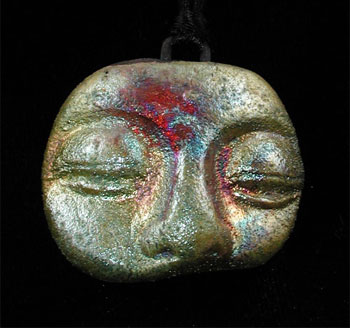
Ceramic art by Issaquah, Washington artist, poet, and Zen teacher, Anita Feng.

Behavioral Emergencies at Dharma Centers:
A Compassionate, Mindful Response
Though rare, it does happen from time to time that unstable individuals engage in disruptive, possibly frightening, or even dangerous behavior at Dharma centers, on retreats, or in interactions with teachers or sangha members. After experiencing such an incident last year, Dan Peterson of the Shambhala Meditation Center of Seattle created a detailed protocol to help other teachers and sangha leaders prepare themselves and their Dharma groups in case a difficult situation should arise.
The complete document, “Working with Behavioral Emergencies at Dharma Centers” will be available soon on the Northwest Dharma interactive forum, TeacherSpace. Introductory comments and other excerpts from the protocol follow.
“Working with Behavioral Emergencies at Dharma Centers”
Extreme behaviors unexpectedly wake us up. Shocking moments of vividness can also rouse fear. When fear arises we feel the need to protect ourselves, and our propensities for passion, aggression, and ignorance are unleashed. Occasionally individuals act out at Dharma centers, and this can challenge us in unexpected ways. How do we react – what are our feelings? How do we regard the person experiencing such apparent difficulties?
Noticing:
As Buddhist practitioners we have training that helps us to simply notice. We notice our visceral state – adrenaline, emotions, physical tightening. Perhaps we might notice a deep sadness – violence is very, very old, and we have encountered such situations many times already. Most of us shut down very quickly when a shocking event occurs – we cannot stand to remain for long in such vivid awareness.
We also notice the person having the upheaval or outburst. There is a lot of intelligence in such situations. All behavior has a communicative function. It is not that the person is making a conscious expression, but a great deal is being communicated with the behavior. So we simply notice the person and what they are doing.
We also notice the environment altogether. How are other people responding? Violence can evoke powerful reactions. Is anyone having particular problems in response, is anyone adding further fuel to the situation, is anyone in physical danger? Is the person acting to destroy property at the Dharma center?
The ground of skillfully entering extreme situations is the capacity to notice. It is helpful to think through a number of issues in advance as well…
Advance thinking:
Who steps in when a person acts out? Is it the teacher, the coordinator, the center administrator, the person leading meditation? This may vary from organization to organization, and also from situation to situation. But it might be a good idea to have a discussion about this, because it is so common to freeze. The discussion itself helps clarify what is already in place, the relationships and roles we each have in our communities. If one or two people know they are serving to protect the situation that can be something of an antidote when we are stunned by unfolding events.
What is it that is being protected? Our Buddhist practice has been working towards undermining the solidity of ego. Vivid events might dislodge fixed mind – but they can also point to our tendency to shut down, solidify a sense of self and other, to objectify perceived threats. Dharma protection is protecting access to experiencing our true nature. We are protecting our open hearts, the teachers who provide instruction, the environment of practice, and the Sangha.
Extreme behavior:
[The guide gives information on mania, psychosis, depression, and disorientation, as well as non-psychiatric disruptive states.]
Being stunned by extremes dulls us, and waking from that has a quality of softening and letting go – letting go of the seeming solidity of the situation. Confidence is described as the practical manifestation of gentleness. It is necessary to be gentle to ourselves to see where we have solidified in a reactive way in extreme situations and that gentleness is a balm that opens us up so that we can skillfully act.
Skillful actions:
[These include being aware of a distortion of time sense, remaining present, being gentle, de-escalating with non-judgmental empathy and by reducing stimulation and attention. For a situation when de-escalation fails, advice is given on advance preparation of emergency numbers, getting intervention, interacting with police and emergency workers, following up with authorities. Issues of confidentiality and after care for sangha members are also addressed.]
For center members:
It is helpful to communicate to others that assistance is being provided and minimize disruptions to planned activities and events. Continuing with a program, if possible, keeps others engaged and helps minimize attention to the individual in crisis. This is an opportunity to bring upheavals to the path and sometimes there is an unanticipated richness that comes after a disturbing event if one is able to practice.
…When we bring our experience to practice we have an opportunity to strengthen our capacity to remain awake in a vast rich world.
For more information, you may contact Dan Peterson at peterhana@comcast.net. To learn more about Shambhala Meditation Center of Seattle, please visit: www.seattle.shambhala.org.
Contributor: Dan Peterson.
Ceramic art & photo: Anita Feng, rakubuddha.blogspot.com.